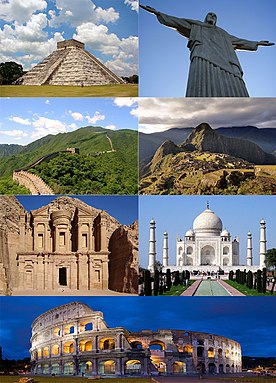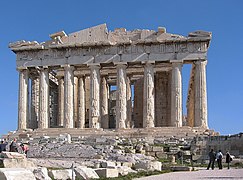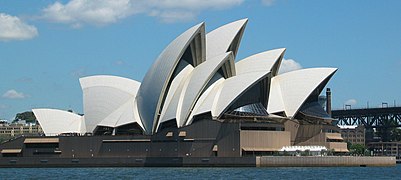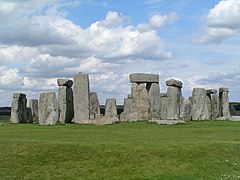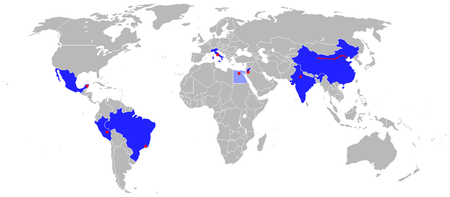New seven wonders of the modern world
The new seven wonders of the modern world are the monuments that were the winners in a public and international competition held in 2007, inspired by the list of the seven wonders of the ancient world and carried out by a private company by the name of New Open World Corporation. More than one hundred million votes, through the Internet and SMS, resulted in this new classification. The initiative came from the Swiss businessman Bernard Weber, founder of the company.
The seven modern wonders are: Chichén Itzá, in Yucatán, Mexico; The Colosseum in Rome, Italy; the statue of Christ the Redeemer, in Rio de Janeiro, Brazil; the Great Wall of China, in China; Machu Picchu, in the department of Cuzco, Peru; Petra, in Jordan; and the Taj Mahal, in Agra, India.
Ancient Seven Wonders
The seven wonders of the world known to the Hellenistic Greeks were selected by the Dutch painter Maerten van Heemskrerck in the 16th century in a series of seven paintings, which show the architectural and sculptural works that marked a before and after in history. Previously, authors such as Philo of Byzantium, Antipater of Sidon, Gregorio Nacianceno or Bede the Venerable, among others, had made their respective listings. Only one of them is currently standing. While the existence of others is still a mystery for researchers and experts in the field. The most frequently asked question is: why did they choose only seven landmarks? Hellenistic culture considered such a figure as the perfect number.
Voting system
The vote was public. Participants had to register an email on the corporation's website and choose their favorite candidates. It was also possible to vote via SMS and through a paid telephone number or, where appropriate, a vote on Facebook through a publication using emojis as a measurement system, among which we find: I like it, I love it, among others. One of the criticisms of the system used was that in practice nothing prevented the same person from voting more than once, as long as they did so from a different email or SMS. It was possible to vote for a single candidate and receive a certificate of the specific vote by paying two US dollars.
<p In the last months of the vote, only the 21 candidates who until then had obtained the greatest number of votes participated.Faced with the protests of the Egyptian government in the final stage, the Pyramids of Guiza was eliminated from the list, a fact that was disguised by the organizers assigning this the status of honorary candidate, because it is the only one of the seven Wonders of the ancient world that remains standing.
This selection admitted man -created structures until 2000, with the condition that they were standing today. The results were released on 07/07/07, that is, on July 7, 2007 in Estadio da Luz, in Lisbon (Portugal), in a great ceremony.
Acts, contrasts and figures
- The ceremony of the announcement of new wonders was transmitted live by more than 160 television channels to more than 170 countries.
- In the first phase of the ballot, more than half of the countries members of the Unesco had a prominent monument competing to become one of the New Wonders of the World, which led to the political support of many of their respective governments.
- The Seven New Wonders chosen have been declared a UNESCO World Heritage Site, as listed in 2012.
- After the vote was finished for the seven new wonders of the world, the search began to choose the Seven Natural Wonders of the World, which reached its goal on November 11, 2011.
Wonder in honor
The Great Pyramid of Giza (Egypt) was considered to be the eighth honorary wonder. The Great Pyramid had been excluded from the vote, as it was the oldest and the only one that still survives of the seven wonders of the ancient world. The event occurred in the context of great opposition from the Egyptian cultural authorities, such as Zahi Hawass, general secretary of the Egyptian government's Higher Council of Antiquities (Minister of Antiquities until 2011), who described this contest as an "advertising operation"..
Chosen
- Chichén Itzá, in Yucatan, Mexico.
- The Colosseum of Rome in Italy
- The statue of Christ Redeemer, in Rio de Janeiro, Brazil.
- The Great Wall China, in China.
- Machu Picchu, in the department of Cuzco, Peru
- Petra, Jordan.
- Taj Mahal, in Agra, India.
Candidates
After a voting time, the 77 semifinalists were released in this order:
- Christ Redentor, Rio de Janeiro, Brazil
- Machu Picchu, Cuzco, Peru
- Great Wall, China
- Petra, Jordan
- Taj Mahal, India
- Colosseum of Rome, Italy
- Chichen Itzá, Mexico
- Eiffel Tower, France
- Tower of Pisa, Italy
- Kremlin, Cathedral of St Basil and Red Square of Moscow, Russia
- Historic City of Sana ' a, Yemén
- Palace of Versailles, France
- La Giralda, Spain
- Alhambra, Spain
- Angkor Wat, Cambodia
- Estatua de la Libertad, Estados Unidos
- Temple of the Holy Family, Spain
- Church of Santa Sofia, Turkey
- Sydney Opera, Australia
- Potala Palace, China
- Golden Gate, United States
- Moais de la Isla de Pascua, Chile
- Djingareyber Mosque, Mali
- Temple of Meenakshi Amman, India
- Tokyo Imperial Palace, Japan
- Empire State, United States
- Cathedral of Aachen, Germany
- Golden Temple, India
- Acropolis of Athens, Greece
- Temple of Brihadeshwara, India
- Arunachaleswara Temple, India
- Bahubali Statue, India
- Santiago de Compostela, Spain
- Budapest Parliament, Hungary
- Stonehenge, Great Britain
- Neuschwanstein, Germany
- Mahabalipuram, India
- Goeltzschtal Bridge, Germany
- Dhammakaya Cetiya, Thailand
- Cologne Cathedral, Germany
- Church of Our Lady of Dresden, Germany
- Pyramids of Guiza, Egypt
- Lotus Temple, India
- Terracotta Warriors, China
- Prague Castle, Czech Republic
- Forbidden City, China
- Kapellbrücke, Switzerland
- Tower of London, Great Britain
- Petronas Towers, Malaysia
- Olympic Stadium in Munich, Germany
- Kiyomizu-dera, Japan
- Sigiriya, Sri Lanka
- Parliament of the United Kingdom, Great Britain
- Mezquita-catedral de Córdoba, Spain
- Abu Simbel, Egypt
- Cathedral of Saint Paul of London, Great Britain
- Teotihuacán, Mexico
- Palace Ducal Italy
- London Eye, Great Britain
- Charles Bridge, Czech Republic
- Basilica of Saint Peter, Vatican City
- Ranakpur Temple, India
- Big Ben, Great Britain
- Monte Rushmore, United States
- Guggenheim Museum Bilbao, Spain
- Lines of Nazca, Peru
- Monte Saint-Michel, France
- Hotel Burj Al Arab, United Arab Emirates
- Sistine Chapel, Vatican City
- Palacio Real de Madrid, Spain
- Greenwich Observatory, Great Britain
- CN Tower, Canada
- Valley of the Kings, Egypt
- Newgrange Megalithic Tomb, Ireland
- Aqueducto de Segovia, Spain
- Panathinaiko Stadium, Greece
- Panama Canal, Panama
Finalists
Criticism
The project has been criticized for different reasons:
- The Unesco, an entity of the United Nations that declares as a World Heritage Site to sites of cultural or natural importance, did not give the endorsement for this campaign, for considering it media and personal title of Weber. He stated that the sentimental value of the monuments is not sufficient to include it in a list of the characteristics that are intended. The international agency stated that the vote is not universal, while leaving millions of people who do not have access to the internet, and that the list of candidates was created under unscientific and educational criteria.
- There were those who thought it was a project for economic purposes (by having to pay to vote on the phone for example) although Bernard Weber claimed that the benefits of this project would be intended for the restoration of monuments.
- Another criticism made by some art scholars is the fact that the seven wonders are chosen by a vote, when artistic merit is not chosen by a vote and less by people who have no artistic knowledge.
- Others such as the director of Chichén Itzá thought that such initiatives foster competitiveness and discrimination.
- Some people in Egypt thought that the Pyramids of Gizeh do not have to compete with modern buildings, for example the Sydney Opera and even some have accused the project of "absurd".
Contenido relacionado
Etruscans
Cantabrian lábaro
Garcia I of Leon
